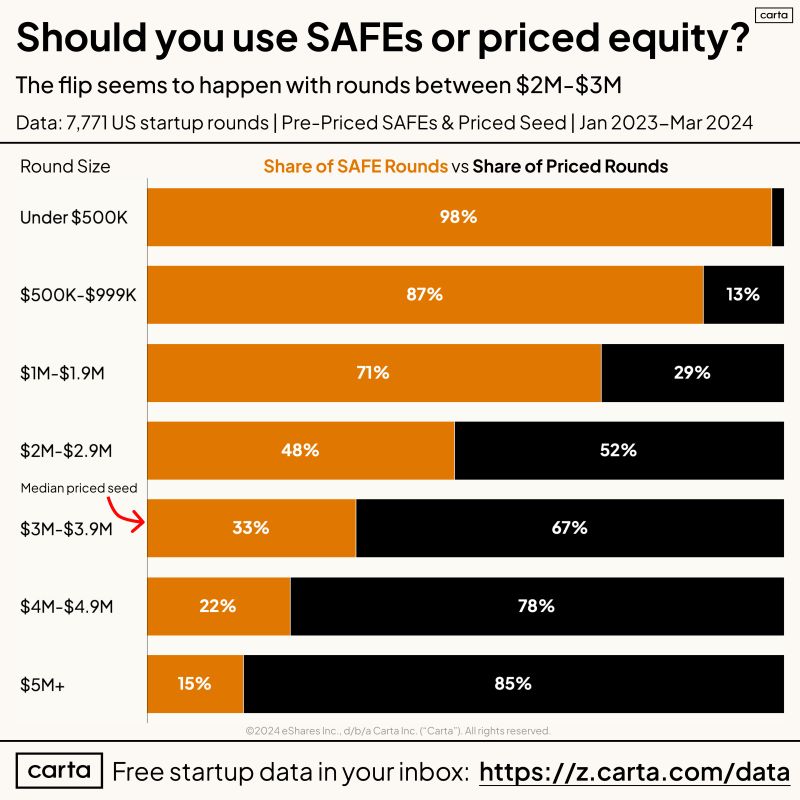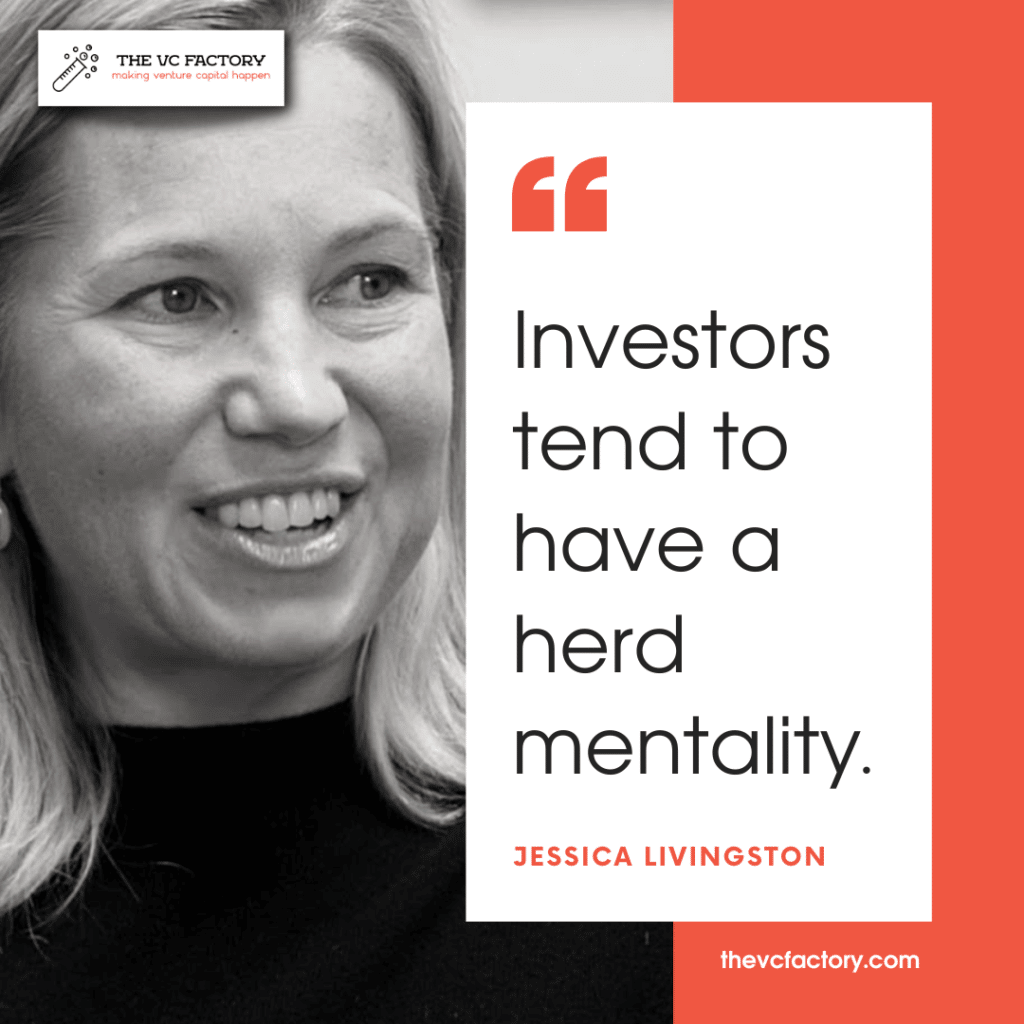The Problem With SAFEs In Venture Capital

In recent years, Simple Agreements for Future Equity (SAFEs) have skyrocketed in popularity, becoming the de facto instrument for early-stage startup investing. While they offer undeniable advantages, such as speed and cost-effectiveness, there are pitfalls and nuances that demand attention. The recent VC market correction has highlighted frailties in the system. The way SAFEs have come to be used is far from the initial intention, which poses additional problems. In this article and the companion webinar, I explore the origins of SAFEs, their advantages, and the issues that arise when they are misused. Finally, I dissect the pros and cons, sharing tips for using SAFEs optimally and addressing common misconceptions.
In This Post
Accelerate Your Learning: Watch Our Webinar!
Don’t just read about it, immerse yourself in the content through our companion webinar for this post! Engage with a multimedia presentation, discover all the referenced sources, and have your questions answered live! Click the “Watch Now” button to access the webinar.

Understanding SAFEs
In the last decade, SAFEs have emerged as a popular tool for raising capital. But what exactly are SAFEs, where did they originate, and why are they used in the first place? In this section, I answer these fundamental questions.
SAFEs are financial instruments startups use to secure investment mostly from Angel Investors, and sometimes very early-stage Venture capitalists. They have gained widespread adoption, especially in Silicon Valley, as an alternative to traditional equity financing methods like common or preferred stock.
SAFEs and equity rounds, like traditional Series A or Series B rounds, both serve as mechanisms for early-stage startups to raise capital. However, they differ significantly in their structure and timing.
Equity rounds involve the immediate exchange of ownership shares in the company for investment, establishing a valuation for the startup at that moment. However, in the nascent stages of a startup’s journey, determining an accurate valuation is like shooting in the dark. Startups often lack the necessary performance metrics, customer traction, or revenue streams that would typically inform a valuation. Read the article below to understand how VCs evaluate startups.
SAFEs, on the other hand, postpone the valuation discussion until a later, more substantial funding event (or, in some cases, a specific triggering event). This approach allows both Founders and Investors to focus on what truly matters at this early juncture: building a viable product and growing the business without getting bogged down in complex valuation negotiations.
When the next priced equity round (i.e., a funding round with a determined price per share) occurs, the SAFEs are typically converted into shares in the startup based on the predetermined terms negotiated in the initial SAFE agreement.
This deferral of valuation negotiations also simplifies and expedites the fundraising process, making SAFEs a favored choice for startups seeking swift access to capital. However, it also introduces a degree of uncertainty, as the actual equity allocation is determined in the future, potentially affecting the Investor’s stake.

SAFEs have won the battle against price equity under $2 million raised. (Source: CARTA)
Recent data shows that SAFEs are the preferred instrument for round sizes under $2 million. Follow CARTA’s Peter Walker on LinkedIn or on X for more data on SAFEs and early-stage investing. Carta’s data seems skewed towards “VC super users”, companies raising lots of SAFEs and equity, so it’s worth recouping with other sources.
Compensating for Risk: Cap and Discount
Investors in SAFEs deserve appropriate compensation for the substantial risks they undertake. They inject capital when a company is in its infancy, typically with unproven concepts and limited traction. In contrast, the next round of Investors will likely benefit from the progress achieved with the funds raised through SAFEs.
SAFEs incorporate risk-rewards mechanisms like valuation caps and discount rates to ensure that early backers are duly compensated for their faith in the startup’s potential.
Valuation Cap: The cap sets a maximum limit on the conversion price of the SAFE into equity during a future financing round. This means that even if the startup’s valuation skyrockets, the Investor’s conversion price will never exceed the cap. For instance, if an investor holds a SAFE with a $5 million valuation cap and the subsequent funding round values the startup at $10 million, the investor’s SAFE converts at the cap price, effectively giving them twice the equity for their investment. (Watch the webinar for detailed calculations).
Discount Rate: The discount rate entitles Investors to purchase shares at a predetermined discount compared to the price paid by the new Investors in the subsequent equity round. This discount acknowledges the risk early Investors took by putting their money into the venture before its value was proven. Typically, discounts range from 10% to 30%, providing investors with a favorable conversion rate and incentivizing early participation. The higher the discount rate, the higher Founders’ dilution.

Valuation caps are a staple feature of SAFEs, despite posing many problems highlighted below. (Source: CARTA)
CARTA startups overwhelmingly favor caps, which are sometimes coupled with a discount. Watch the webinar for detailed calculations.
Pre-Money SAFEs and Post-Money SAFEs
Y Combinator (YC) introduced SAFEs in 2013 to simplify and expedite the investment process for early-stage startups’ Founders and Investors. (Note: Adeo Ressi recently commented on my LinkedIn post that he had devised the SAFE before YC).
Before SAFEs, startups typically relied on convertible notes (or bonds), which often involved complex terms and legal documentation. SAFEs aimed to streamline this process by offering a straightforward and standardized agreement.
Two key terms concerning SAFEs are “pre-money SAFEs” and “post-money SAFEs.” These terms refer to when the SAFE’s conversion into equity occurs concerning the startup’s valuation:
- Pre-money SAFE: With a pre-money SAFE, the valuation at which the SAFE holder’s investment converts is determined before the inclusion of the new capital from the subsequent equity financing round. This means the SAFE holder’s equity stake gets diluted by the new equity investors.
- Post-money SAFE: In contrast, with a post-money SAFE, the valuation cap includes the SAFE holder’s money. This means that the valuation at which the SAFE converts reflects the startup’s valuation after accounting for the SAFE but before the new equity financing. As a result, the SAFE holder’s equity stake is not diluted by subsequent equity investors in that round. Existing option pools are also included in the cap (but not new ones).
The choice between pre-money and post-money SAFEs can significantly impact both the Investor and the startup, as it determines the dilution of ownership for existing shareholders. I personally prefer using post-money SAFEs as they considerably simplify dilution calculations. Carta data shows that the post-money SAFE is now the default type, used in over 85% of transactions as of Q1 2024.
In the next section, I’ll delve into the advantages and disadvantages of SAFEs, offering a comprehensive view of their role in startup financing.
Pros and Cons of SAFEs
SAFEs have become incredibly popular and for good reason. They offer a range of benefits for both entrepreneurs and Investors. However, like any financial instrument, SAFEs come with their own set of advantages and disadvantages, especially when they are not used as initially intended.
Pros of SAFEs
One of the primary advantages of SAFEs is their ability to break the “Who else is investing?” deadlock often encountered in startup financing, especially when compared to traditional priced equity rounds requiring all Investors to sign a term sheet simultaneously.
This deadlock arises from Investors’ tendency to exhibit herd behavior (see the article below for more context). In traditional rounds, Investors may hesitate to commit until they see other prominent names on board. SAFEs, on the other hand, allow investors to join the round without waiting for everyone else to sign, thus facilitating a smoother and faster fundraising process for startups.
Several additional key reasons contribute to the popularity of SAFEs among startups Founders and Investors.
Simplicity: SAFEs are relatively simple agreements, reducing the time and legal costs associated with fundraising. YC’s SAFE template is only a few pages long.
Speed: SAFEs allow startups to secure investment quickly. With standardized terms, negotiations are minimal, enabling startups to focus on growth rather than lengthy legal processes. Investors are not shareholders, so no shareholders’ agreement is necessary.
SAFEs allow Founders to get the money in the bank and get back to work.
Geoff Ralston – Y Combinator (Source: 20VC)
Flexibility: SAFEs don’t carry an interest rate or a maturity date, which is common in convertible notes. Startups also avoid the pressure of debt repayment.
Deferred Valuation: SAFEs (theoretically—more about this later) postpone the startup’s valuation until a future priced equity round, typically at Series A. This delay can be advantageous for both parties, as it avoids discussions over the startup’s valuation at an early stage. Dilution is postponed at a later stage when the company has enough traction to get a proper valuation.
Cons of SAFEs
For all their advantages, SAFEs have been long criticized for several reasons, with a marked increase since the VC market reset in 2022.
In my experience, the primary issue with SAFEs lies in the misalignment of interests between SAFE holders (typically, Angel Investors) and Founders. Angel Investors may be inclined to press Founders to halt a fundraising round once the valuation proposed by new round Investors reaches the predefined cap.
In contrast, Founders often prefer to explore the market further, seeking better offers that could potentially dilute them less. This misalignment can create tension and conflicts of interest during the fundraising process, potentially impacting the startup’s growth trajectory. Watch the webinar for more details on this thorny issue, where I share an example from a recent transaction.
More commonly cited issues with SAFEs are mentioned below.
Uncertainty for Investors: SAFEs provide minimal protection for Investors in case the startup doesn’t perform as expected. Unlike equity investors who have certain rights and preferences, SAFE holders may find themselves in a precarious position if the company encounters difficulties. as the recent wave of bankruptcies highlighted. Although many Angel groups profess not to use SAFEs for that reason, the point may be moot. Startups have rarely own assets and have little salvage value.
Complex Cap Table: Over time, as more SAFEs convert into equity and multiple SAFEs with varying terms are in play, the startup’s capitalization table (cap table) can become complex. Managing this complexity can be challenging for Founders. Tools like Carta’s SAFE calculator help them make sense of potential dilution.
I cannot tell you how many angry pissed off angel investors I have had to talk off the ledge when we are leading a priced round and they see the cap table and they own a LOT less than they thought they did.
Fred Wilson – Union Square VEntures (Source: his awesome blog)
Delayed Ownership Rights: SAFE Investors typically don’t have voting rights or any say in company decisions until conversion. This means they may not have a voice in crucial matters until much later in the startup’s journey.
No Priced Round: If the startup does not issue a priced round, the SAFEs “are just going to sit there in a state of (technically) eternal limbo”, as a legaltech Founder told me.
Toptal’s experience with convertible notes highlights this potential pitfall. The company issued notes to early Investors and employees, expecting them to convert to equity in a future funding round. However, Toptal remained bootstrapped and profitable, avoiding new funding rounds and leaving note holders without equity.
I’ve worked on deals where this issue was circumvented by adding a clause to convert the SAFE into stock at the middle of the floor and cap valuations (an argument in favor of having them). Also, startups rarely reach profitability with a SAFE round.
Conversion into preferred shares: SAFEs ultimately convert into the next round’s instrument, typically preferred shares with liquidation preference granting Investors the right to receive their initial investment amount back first. It can create a complex stack of preferences potentially diluting the ownership and value for common shareholders, including Founders and employees, in favor of Investors. Read this article to understand the full extent of liquidation preference’s drawbacks.
Worse, SAFEs with valuation caps provide full ratchet provisions benefitting Investors. As highlighted in the article below, full ratchets are very detrimental to Founders.
Investors try to limit some of these drawbacks with SAFE side letters, which grant them preemptive rights for future financing, extended information rights, and sometimes some kind of preference in liquidation. However, it considerably lengthen the process, which defeats the purpose of using SAFEs in the first place.
How To Use SAFEs Optimally
In this concluding section, I mention best practices for utilizing SAFEs to their fullest extent. I explore each of these points in depth in the companion webinar.
- When to use SAFEs: What are the scenarios in which SAFEs are preferable vs. traditional priced equity rounds and convertible notes, and when to avoid them.
- Why Discounts Trump Caps: Learn about the complexities of valuation caps and understand why discounts often prove to be the more advantageous choice for both Founders and Investors.
- Back to Basics: SAFEs with Varied Conditions: Explore the idea of using SAFEs as initially intended, implementing different conditions for Investors based on preset parameters.
- Mastering Negotiation: Factors Shaping Your Deal: Uncover the key factors that can help you negotiate the discount rate or valuation cap to your advantage.
Join us in our exclusive webinar as we navigate these critical aspects of SAFEs both for Founders and Investors. Don’t miss out on this opportunity to enhance your understanding and make informed decisions!

Go Further: Watch the webinar now!
Conclusion: tl;dr
SAFEs have become a popular choice for startups looking to raise funds quickly and with minimal hassle. However, this simplicity often masks deeper issues. The lack of standardization can lead to confusion and disputes, while the conversion mechanics might leave Investors at a disadvantage if not meticulously structured. Additionally, the very appeal of SAFEs—ease and speed—can sometimes lead Founders to overlook critical details, resulting in significant headaches down the line.
Ultimately, while SAFEs offer a quick fix, they are not a one-size-fits-all solution. Both Founders and Investors need to approach them with caution, ensuring they fully understand the terms and implications. As with any funding tool, the key is to strike a balance between convenience and thoroughness, ensuring that the chosen instrument aligns with the long-term vision and stability of the startup.



